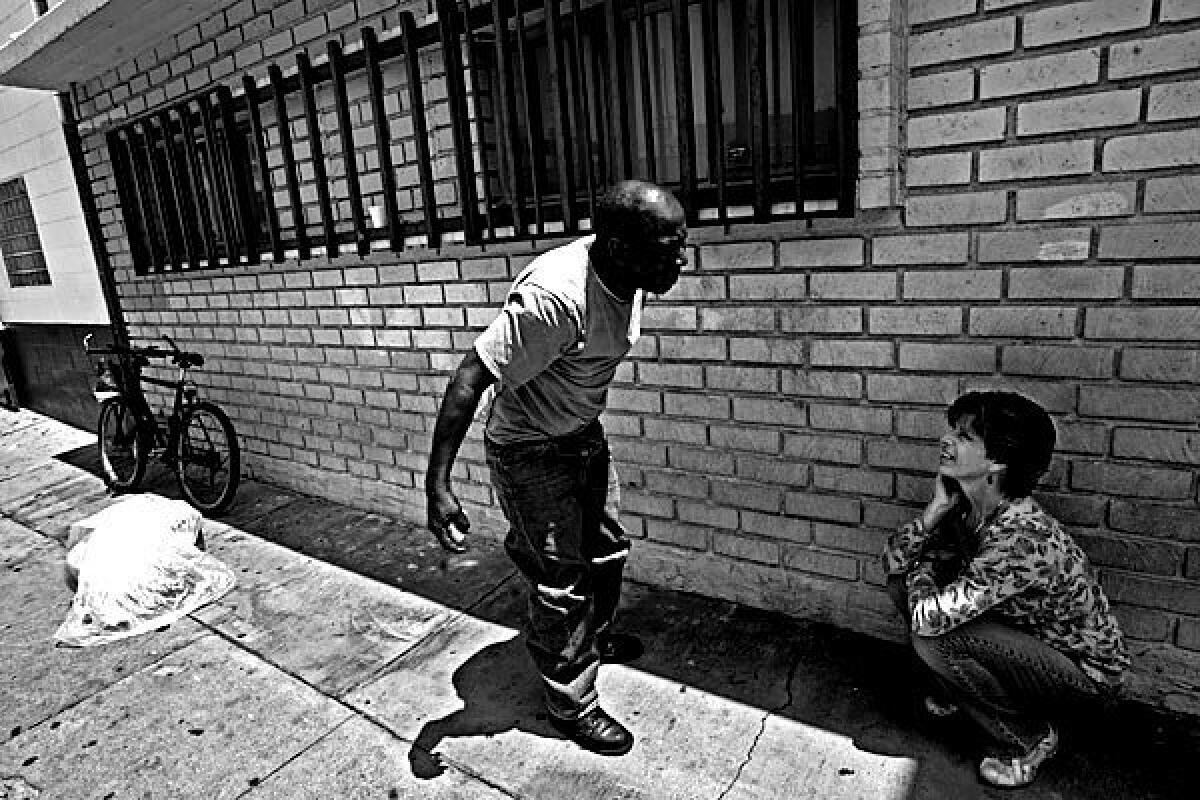Homes for the hardest of the hard-core homeless

- Share via
The searchers carved skid row into quadrants and advanced in small groups, aiming flashlights into the cold.
They moved between nylon tents and cardboard lean-tos in the Toy District, where junkies had stripped the streetlights and left whole blocks in darkness. They roused the human bundles scattered around the tumbledown hotels and freshly painted lofts on Main Street, wasted faces blinking into their flashlights.
They looked in the eastern section called the Bottoms, around the big missions and flea traps, and around the neighborhood’s forbidding eastern edge, a zone of industrial warehouses and razor wire known as the Low Bottoms, where even now, hours before daylight, the crack trade was brisk.
The searchers, a couple dozen volunteers and Los Angeles County workers, had orders: Interview everyone living on these streets. Find out how long they’ve been homeless. Ask about their addictions, their mental and physical health.
Carrie Bach, a 54-year-old nurse with the Public Health Department, was leading one of the teams, a scarf around her neck and a walkie-talkie in her mittens. As her department’s homelessness coordinator, she knew skid row better than most. But she felt nervous and a little naive. She had never glimpsed the Boschian tableau that materialized after the warehouses bolted their doors, after the corrugated-metal gates rolled down over the church fronts, cheap-toy outlets and fake-flower shops.
She hadn’t seen the pavement scattered with bodies, the spectral shapes swaying against the cinder-block walls, the mounds of garbage screeching with rats. For some searchers, it was too much. They handed back their clipboards and went home.
The canvass marked the beginning of a two-year, $3.6-million plan, launched by county Supervisor Zev Yaroslavsky, to find the 50 people likeliest to die on skid row’s streets — the hardest of the hard cases — and house them however possible.
Scuttling decades of settled wisdom, Project 50 would not demand that they quit drugs or stop drinking. Nor would they be required to seek psychiatric help.
Rather than allow the homeless to grind endlessly through the machinery of missions, lockups and hospitals, why not just give them an apartment key? Rather than force them into treatment programs, why not settle them in a room and offer all the help they’d take?
This method, called “housing first,” was meant to do more than save lives. The hard-core homeless cost taxpayers hugely in emergency services, and studies showed that putting them in apartments, with access to doctors and counselors, slashed those costs. If it worked on Los Angeles’ skid row, that infamous 50-square-block netherworld sometimes called the nation’s “ground zero for homelessness,” it bore promise of redefining homeless policy everywhere.
As Bach searched the streets that night in December 2007, she found two worn-looking women huddled against a wall and tried in her polite, persistent way to interview them. Suddenly an angry man wearing too much jewelry was standing threateningly in her face. Later, someone explained: their pimp.
For Bach, who would soon be named the project director, much of the next year would echo that encounter: a struggle to decipher a world not her own. She was a grandmother who carried a Bible in her Buick and worked the soundboard of her Presbyterian church. She talked to God in traffic and asked forgiveness when she cursed.
She had narrowly avoided homelessness herself. Her first marriage had ended in destitution, leaving her living in a borrowed cabin in the woods near Big Bear, where she sewed clothes for her three girls and warmed their bedsheets with a skillet on cold nights. She was remarried now, to a sweet, burly man who suffered from manic- depression and took his pills religiously.
She knew she would now confront extremes of despair and uncertainty far beyond her own experience. Over nine nights, she and the other volunteers found 471 people living on the grid bounded by Main Street and Central Avenue, 3rd and 7th streets, which encompassed all but a deserted sliver of skid row. Of that number, 350 people answered detailed questions about their health, habits and psychiatric history.
The list was soon ready, the names studied and boiled down to the 50 worst cases. Many had some combination of addiction, mental illness, chronic disease, advanced age and more than six months on the streets.
Six months: That was the directive from the county chief executive’s office. Find everyone on the list and get them housed in six months. In mid-January, the Project 50 team fanned out to the streets and alleys, soup kitchens and missions, clinics and storefront churches.
“Whatever it takes” would be the motto, speed the watchword.
*****
The rooms weren’t much, just cell-size efficiencies in a cluster of refurbished downtown flophouses. A bed, a sink, a dresser, tile floor, and windows that overlooked dirty courtyards. Shared kitchens and bathrooms. Halls redolent of cleaning chemicals. Lobbies with vending machines and mounted televisions.
Maurice Lewis, No. 36 on the list, got the first key.
Lewis, who frequented the Los Angeles Mission, was easily found. He had a glowering stare and big shoulders hunched in bulky clothes. He had been homeless for about a year off and on, he explained, drifting around downtown, sleeping on buses. He was 54 but looked a good decade older.
He’d spent years “drinkin’ and druggin’,” he said, and heard voices in his head. He displayed an expired merchant marine license and mumbled about getting back to the sea.
The terms of Project 50 were explained to him: We have a room for you, your very own. You don’t have to see a shrink. You don’t have to attend substance abuse counseling. All that’s required is that 30% of your income — in Lewis’ case, a $221 monthly general relief check from the county — go toward rent.
Lewis seemed wary of the eager-faced people ushering him to the Senator Hotel on Main Street. He opened the door and surveyed the featureless 10-by-15-foot room. The third-floor window overlooked the street’s round-the-clock drug transactions.
His wariness turned to anger when he learned the lock hadn’t been changed since the last tenant moved out, which meant, he was convinced, that the person might return any time; he’d be easy prey, confined within four strange walls. He handed back the key and headed to the streets, where he felt safer.
The lock was quickly changed, a fresh key offered. And in the last week of January 2008, as Lewis moved in, Bach’s team could count its first tentative victory.
The following week, Bobby Livingston, No. 1 on the list, moved in a floor below Lewis. He was 64, with schizophrenia, asthma, a crack habit and a love of brawling. He had survived on skid row for 37 years, longer than anyone else they’d found, and if anyone tested the program’s premise, Bach thought, it would be Livingston. Whether he was capable of changing much — whether he had any desire to change — was anyone’s guess.
Down the block, a week later, Cliff Butler, No. 46, moved into the Sanborn Hotel. At 52, he was bipolar and industrious. He called himself the Polish Man, financing his $150-a-day cocaine habit by shining big rigs. “This ain’t a bunch of mental midgets. Even the mentally ill have developed a con or hustle,” said Butler, speaking as much about himself as the other clients.
In late February came Paul Sigler, No. 49, who had a familiar combination of afflictions — manic-depression and crack addiction — but presented a puzzle. He was 44, with striking light-blue eyes, one of skid row’s few white men. “I used to be a millionaire,” he repeated as he settled into the Senator.
It sounded like the delusion of someone eager to distance himself from the wretched cases around him, but Bach — who thought she heard the remote echo of privilege in his speech — refused to draw conclusions about him. It was impossible to tell who was telling the truth down here.
In early April they found No. 5, Wanda Hammond, who was huddled on the pavement half-clothed, where she had been prey to sexual attacks. She was 49, mentally ill and known as a “strawberry,” a woman who traded sex for a fix.
Only after she’d found the rock cocaine and pinch of heroin in her blankets, only after she’d shambled down the street to buy the pipe and hypodermic to deliver the double blast, did she reluctantly climb into a car with outreach workers.
At the detox center in Long Beach, nurses found her back crawling with scabies and turned her away. Back on skid row, Bach snapped on gloves, smeared permethrin ointment on the infection, then raced to the detox center before it closed. This time, the nurse objected because Bach hadn’t applied the ointment head to toe as protocol required. When Bach made it clear that she was ready to stand there and argue all night, the nurse admitted Hammond.
Two weeks later, Hammond walked into Project 50 headquarters, smiling, and Bach greeted her with a hug and a bouquet of flowers. Hammond moved into the Senator that day.
In May the outreach team found Cathy McFee, No. 3, a hollow-cheeked transsexual with hoop earrings, tight black curls plastered to her scalp with Vaseline and a floral-print dress draped awkwardly on a square 5-foot-3 frame.
“If I get my hands on my check, I don’t care what anybody say, I’m gonna go astray,” McFee, 62, told Bach as they rode to the Social Security office. “No matter what I say, please…”
“Money is my — what do you call it?” McFee said.
“Achilles’ heel?” Bach said.
“Money makes me want it. I gotta get that urge off me that’s in my brain.”
McFee sat uncomfortably in the back of the car. Doctors had removed a malignant tumor from her leg the year before, but the wound never healed. She was ashamed to sleep in shelters because people recoiled from the smell, which she tried to mask with 99-cent cologne. Now and then, someone would decide it was time to call her an ambulance. In the last year, she’d racked up 15 emergency room days and 26 inpatient hospital days, a taxpayer tab of about $90,000.
She had four children somewhere, but during eight years on L.A.’s streets she’d mislaid their photos, along with her anti-depression pills. Twice, she’d been shot for stealing other people’s drugs.
For McFee, the day was proving exhausting — in and out of the car, government counters, housing forms, welfare forms, ID forms: There were countless pieces of paperwork needed to bring a ghost off the streets. Bach shepherded her through a gantlet that McFee knew would defeat her completely if she had to face it alone.
It was time for the interview at the Sanborn Hotel, her prospective new home. “Are you sober?” asked building manager Bryant Caver. “Do you use drugs now?”
“I ain’t done nothing in quite a while,” she said vaguely. “I’m trying to save my life. If I mess with that, I’m killing myself.”
“What if the music’s loud next door and you need to sleep?”
“I put cotton in my ears.”
After the interview, she sank back into the car and sighed wearily. There was still another trip, still more paperwork, this time at the city Housing Authority. “Oh, God,” she said.
She got her room the next day. She found a used DVD player and some bootleg movies. “You either gonna be in here getting messed up, or you got something to entertain you,” she said.
Psychological triggers were everywhere. Walking down the hall, she said, she could hear lighters clicking behind the doors and could smell crack vapor seeping out.
To Bach, what distinguished McFee from other addicts she met — what made her seem a more hopeful case — was her frank admission of her helplessness before her cravings. When the beginning of the month arrived, a frantic McFee cashed her welfare check and thrust an envelope of cash at Bach, pleading: Please take it.
Bach apologized. Rules were rules. She couldn’t take a client’s money, and the program didn’t have funds to hire an agency to manage it. With a helpless feeling, she watched the small figure hobble away to find the dope man.
Just a few months into the program, questions were becoming inescapable: Was it possible to keep people under a roof, even if their addictions and mental illness remained untreated? Did “housing first” imply a promise to give more than shelter — to nudge at least some people back into the world, to family, to independence?
Was “whatever it takes” even close to enough?
christopher.goffard@latimes.com
More to Read
Sign up for Essential California
The most important California stories and recommendations in your inbox every morning.
You may occasionally receive promotional content from the Los Angeles Times.











